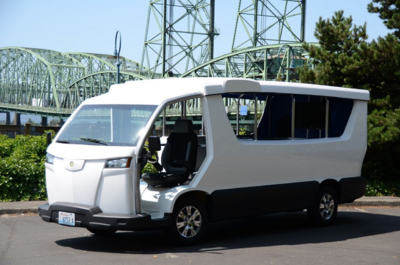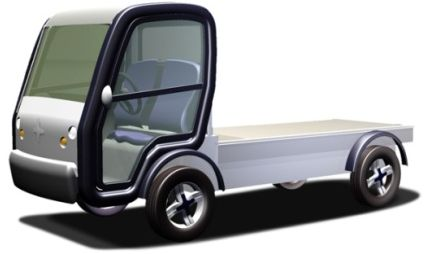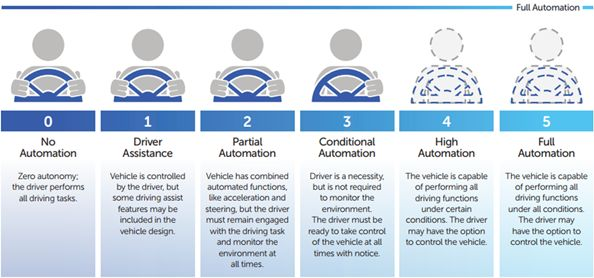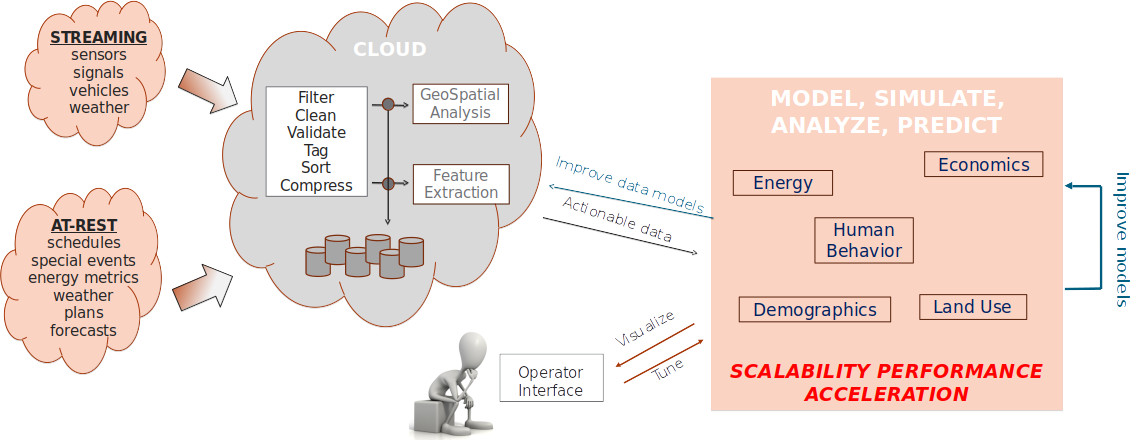Transportation Blueprint
- Authors



 [[File:|x100px|link=Tim Smith]]
[[File:|x100px|link=Tim Smith]]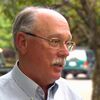


 [[File:|x100px|link=Cory Marshall]]
[[File:|x100px|link=Cory Marshall]]

{{{summary}}}
Introduction
A SuperCluster is a multi-city, multi-stakeholder collaboration organized around common project objectives and shared solutions. Committed cities/communities and partners jointly tackle shared issues, develop and deploy shared solutions to create economies of scale.
The Transportation SuperCluster (TSC) was formed and is managed by forward looking municipalities interested in preparing their infrastructure for new technologies that look set to provide better, more equitable services at lower cost. The TSC mission is to:
- Explore opportunities provided by first and last mile vehicles including shared, low speed and autonomous.
- Examine opportunities for building vibrant communities around transfer points and mobility hubs.
- Clarify how vehicles and hubs can play a role in the last mile delivery of packages and other freight.
- Collaborate with diverse teams developing new and advanced transportation models and environmental sensors that allow both the prediction of probable outcomes and the measurement of actual outcomes of introducing these technologies.
- Work with teams implementing a smart CityWeb to ensure the portability and interchangeability of solutions
- Propose regulatory and policy changes that support the safe deployment of these technologies.
This blueprint will address the range of opportunities offered by new mobility-related technologies. We will provide data about the readiness of these technologies and how we believe they will influence city and community planning offering potential short and long term improvements in safety, equity, climate, employment and congestion.
We want to thank the National Institute of Standards and Technology (NIST) for their leadership in establishing the Global City Teams Challenge. By pulling together city, academic and industry leaders into action clusters and then combining synergistic action clusters into SuperClusters NIST has launched a wave of innovation that will bring lasting benefit to urban life in the US and abroad. In this blueprint we outline bold steps that can benefit mobility in our communities. We have focused on improving first and last mile connections for transit users and last fifty feet for freight delivery. We are interested in addressing transport issues between urban environments in a future version of the blueprint.
Pilot Programs for AV Technologies
In the last few years we have seen three significant shifts in urban mobility,
- sharing,
- electrification, and
- autonomy.
While this document is nominally focused on Autonomous Vehicles many of the desired community benefits can be gained by implementing first and last mile solutions with a shared electric fleet. Further, by running pilots of shared electric fleets that are autonomous ready or partially autonomous we will gain considerable insight into how to deploy autonomous vehicles when the technology is ready for full operation.
The first and last mile pilots are intended to lead cities to a future vision of urban mobility. These pilots will provide considerable learning and inform the pilots that follow.
The first and last mile transportation system should provide:
- Safe pedestrian pathways
- Safe cycling paths
- Urban Speed Vehicles (12mph), buses, cars and specialty vehicles and in this way
- Significantly reduce fatalities because of reduced speed
- Significantly reduced parking space requirements because of vehicle sharing
- Reduced rider cost because of autonomy
The team will start with simple demonstrations that evolve to more complex solutions as understanding is gained. A sample set of demonstrations to start the process could be:
Transit Station to Company Campus:
As an example of transit to company campus a number of large companies in the Portland area are served by TriMet stations that are somewhat distant from campus (such as Nike and Intel). This limits the use of transit unless the company supports a bus service to bridge the gap from transit station to campus (as is done by WeDriveU for Nike). We would propose this function be performed by a connected on demand electric bus transitioning to an autonomous bus which could transport employees from the transit station to the industrial campus and may also be used on campus to deliver passengers to selected buildings.
The scope of the pilot could include access badge readers and/or other systems such as facial recognition. This would assure all riders had appropriate access to campus. Unidentified passengers could be identified and connected to the company security officer for access or denial of access to campus.
Transit Station to College Campus:
Like the previous pilot but with lower identification requirements due to the open nature of campuses, a similar transit station to campus pilot can be started with an electric bus fleet that will evolve over time into an autonomous electric fleet. If successful, the technology could have direct use for many locations.
Transit Station to Public Place (e.g. shopping mall):
Unlike the more homogeneous employee and student pilots, a transit station to public place pilot is more like regular bus service and provides the opportunity to begin development of connected systems to assure passenger safety and reduce rider anxiety. Such topics as rider identification (including ID card, facial recognition technology, biometric ID, etc.) should be investigated. In-vehicle monitored cameras may be used.
Residence to Transit Station:
For this pilot we could use a bus or car. If the bus is relatively small and picks up only passengers in a local neighborhood they may feel safe. With a car which carries 2, 4, or 6 passengers and only collects passengers at one stop this issue is removed.
We can and do share a wide range of vehicles. Most of these rideshare options use conventional high speed gasoline vehicles. The use of traditional gasoline vehicles is driven by the expectation that the rides will use highways. For a last mile solution this capability is not necessary. Urban Speed Vehicles (USVs) are a federally-approved, street-legal vehicle classification under the Federal Motor Vehicle Safety Standard (“FMVSS 1 500”) passed in 1998. Their popularity has grown in niche markets with improvements in battery technology and a broader acceptance of electric vehicles.
City leaders and transportation planners are now incorporating USVs as a critical part of the mass transit solution.
Electric USVs are also the ideal starting point for autonomous vehicles because of their capital and operational cost, safety, and versatility.USVs offer an environmentally friendly approach to first and last mile challenges, expanding the distance most people will travel without a car from ¼ miles to 2 miles. Adding autonomy makes them economical as a door to transit option in all neighborhoods. One major advantage of the FMVSS 500 law is that it does not require the extensive crash testing mandated for high speed vehicles. The lower speed allows the vehicles to use lighter weight construction, modular assembly techniques, and fewer parts. The lower barrier to entrance created by FMVSS 500 law provides companies the ability for greater customization, faster innovation, and shorter time to market. The result is an affordable, practical and sustainable “link” in the transportation system that blends with walking, biking, and mass transit. Further the modularity makes local maintenance and repair possible. As reliable automation becomes available these vehicles will be able to charge themselves and arrive at a customer's door ready for a trip to a transit stop or local business.
Urban Speed Vehicles are not subject to the same crash test and safety regulations making is possible to offer a variety of cab modules on a simple chassis platform. The modular design makes it possible to purpose design and build vehicles to meet fleet requirements. Utilizing standard high quality drive components, including lithium iron phosphate batteries and high end drive train components allows Mobility Cubed to build an affordable, reliable and sustainable electric vehicle. A low parts count combined with design modularity means the vehicle can be “kitted” for local assembly and shipped cost effectively all over the world.
Freight
Freight has many vehicle options including drones for dropping off packages and driverless delivery vehicles. These driverless delivery vehicles could
ferry groceries and other packages to your front door on demand for a low cost per trip. Building out mixed, hub-and-spoke delivery systems, optimizing freight routes, and scheduling deliveries to minimize congestion can significantly reduce costs and improve quality of life. Reducing dwell time of freight vehicles at delivery points is a complex problem requiring close coordination of public and private concerns --- zoning officials, parking authorities, freight services, and building/site managers.
Mobility Hubs
Any transit stop can be turned into a Mobility hub where the first and last mile vehicles are serviced, charged and stored when not in service. At these hubs passenger experience can be improved with digital information signs that respond to real-time conditions, improved lighting, improved pedestrian safety, bike racks, improved safety including CCTV cameras, and much more.
Using technology to increase safety and security at transportation hubs improves ridership and reduces cost. Transit hubs can become business hubs where people stop for food and coffee, to pick up and drop off packages, and to do some local shopping on their way to and from work. Attachment A of this document offers an “EV-Ready Transit Hubs White Paper” exploring this topic in more detail.
Electric Vehicle Charging Infrastructure
We plan to work with Forth Mobility on demonstration projects to advance electric, smart and shared transportation. We plan to work with Portland General Electric Company (PGE) and their efforts to accelerate transportation electrification.
Maintenance and System Operation
Urban Speed Electric Vehicles like Mobility Cubed’s World Bus are constructed with less than 300 major parts, compared to over 2,500 parts for a typical gasoline engine vehicle. In addition, these vehicle’s assembly techniques are significantly less complicated than typical gasoline engine vehicles. The small bill of materials coupled with streamlined assembly processes enable Mobility Cubed to deploy relatively small (5,000 unit) volume runs of vehicles. The vehicles can be assembled and maintained at facilities near their operation, thereby providing local jobs, supporting the local economy, reducing shipping and logistics costs.
Right-of-way Management
Urban Speed electric vehicles can interact with the current built environment in new ways. For example, rather than consider curb pick-up and drop-off these vehicles can come into building spaces without polluting the environment. Picking up directly from transit stops and dropping off in schools, hospitals, universities and offices protects passengers from the elements in ways that have not been possible before. Covered transfer facilitates better protection for patients and people with disabilities.
Similarly last mile freight carried by vehicles that can come into warehouses and factories offers many benefits including clearing the streets. These driverless delivery vehicles and small autonomous drones can ferry groceries and other packages to customer’s front doors on demand for a low cost. Building hub-and-spoke delivery systems, optimizing freight routes, and scheduling deliveries to minimize congestion can significantly reduce costs and improve convenience. Reducing dwell and idle time or getting vehicles off the street completely during delivery requires coordination with public and private concerns, zoning officials, parking authorities, freight services, and building/site managers.
One advantage of autonomous urban speed electric vehicles is that there is no reduction in efficiency, increase in cost or increase in pollution for a larger number of small vehicles. The vehicle can therefore be sized for the appropriate purpose. For example picking people up or dropping packages
at home can be done with a small vehicle whereas taking people or deliveries to a work campus like Intel or Nike can be done with a bus or delivery truck.
Connected Vehicle
Connected urban speed electric AVs can operate without traffic signals. They can synchronize their behavior through vehicle-to-vehicle (V2V) communications at junctions and can operate at safe speeds that change by location and road conditions. Vehicle-to-infrastructure (V2I) communications can be used to activate street lights, get updated route information, open doors, and receive scheduling information.
Transaction Platform
As a citizen moves through a city they interact with city services, transit, schools, parks, and shops. Each of these interactions contains information that can be used to deliver better services. In a smart city each interaction creates a digital transaction informing both the citizen and the city service providers. These transactions should be simple and secure. Ideally they should happen invisibly to the citizen while respecting a citizen's expectations of privacy. For example, as a commuter gets on light rail for the morning commute, there is an interaction between something the commuter carries and the train that completes the ticketing transaction. If the commuter chooses that this transaction be anonymous then the city will know that a passenger stepped onto light rail at one station, off at another and paid the appropriate fare. If the commuter chooses to share personal data with the city then the city will be able to track progress from home to work thus better understanding connections and opportunities to improve the overall commute.
We plan to test such a transactional platform that facilitates low friction data exchange and a personal policy engine that allows each citizen to manage and control how and if to share personal information. We will also test capabilities that allow a service provider to create incentives for citizens to share personal information ensuring the optimal balance between openness and privacy.
CityWeb
Technology becomes more pervasive everyday, and cheaper, faster and easier to use. We expect more from it with every new generation. Two significant technology trends, namely Internet of Things (IoT) and open data, are promising innovation and change at an even greater pace than the usual rapid-fire deployment and adoption of technology. Increased funding in the Smart Cities, Transportation, Grid and Energy sectors, which seek to exploit these trends, are driving the need for greater software development. So are Federal Government initiatives requiring compliance. With IoT and open data, it is becoming increasingly possible to build complex, interoperable software ecosystems that provide us with a richer, more time-efficient, cost-efficient, more energy-efficient and human-friendly digital quality of life.
However, the cost to develop, deploy and maintain these complex technology projects isn't getting correspondingly cheaper or easier. The burden of achieving these goals is still difficult for those in the public sector, academia, or even commercial organizations who might not have deep emerging technology skills. Writing "Smart City" applications can be hard. Often, the software and tooling environment is proprietary and the resulting applications fail to interoperate with applications developed elsewhere. It can also be expensive due to a lack of in-house knowledge, skills and tools for such software.
There is an understandable hesitation in adopting closed, proprietary solutions or even application programming interfaces (API) that are pushed forward by commercial vendors. Even if the API is open, the code supporting it often is not, and locks the consumer into the ecosystem of the commercial vendor, without the ability to interoperate with others. The vertical software stack supporting such alternatives only results in the use case or application sector getting siloed into fragmented ecosystems. There are significant cost and adoption advantages when APIs are not only open but backed by open source communities. Leveraging such available resources (or getting them to cooperate with each other) would be valuable. It would also align with the Federal initiative for a "City Web", which encourages the adoption of common and proven approaches to the Smart City mission.
The President's Council of Advisors on Science and Technology (PCAST) issued a report in 2016 on "Technology and the Future of Cities" , in which they identify the need for more effective approaches 2 to data integration and sharing to solve problems in cities. They point out the:
- Lack of universally accepted platforms and standards.
- City incentives that drive a focus on local issues.
- Incomplete awareness of available solutions.
- Lengthy procurement processes that are unsuitable for agile, iterative, technology-based solutions.
and resulting:
- Uneven distribution of solutions.
- Idiosyncratic implementations.
- Rarely re-usable software for other cities.
- Expensive implementations.
- Disadvantages to smaller cities with fewer resources, less capacity for innovation who fall further behind in the digital quality of life offered to their residents.
There are few private and no public mechanisms today to distribute the new knowledge and data associated with innovations comprehensively across the nation's cities. There is no "app store" specific to city applications...".
Hence they recommend the concept of a comprehensive information infrastructure for cities to use and share, the notion of a "City Web", an formation-sharing platform benefiting all cities, especially those with fewer resources. This would include information on solutions, best practices which have been tried and tested, and had the benefit of experience. "The goal of the City Web is to allow the accumulation and replication of urban solutions and associated data and technologies in ways that benefit cities with different sizes, different technological know-how, and different financial capabilities."
We use the above concept of a "City Web" from the PCAST report to build upon and address these issues and more. To that end, we propose the implementation of "CityWeb", an open data platform and smart city solutions resource. CityWeb can be built and implemented for any locality or Smart City, supplemented by collaboration amongst participants and cities, domain experts and users, and strong open source development communities working in the Smart City technology fields. NIST and US Ignite are working to establish a "CityWeb" project, which has as its goal the implementation and definition of an integrated data management portal and information-sharing platform for Smart City solutions. It is both a resource for Smart City technology solutions as well as a locality-specific portal with links and and archives of information that are relevant to the community. A CityWeb stance can be implemented for each Smart City, with city-specific information. These CityWeb instances are intended to be bolstered by additional resources in the form of an open source software development community contributing to a Software Development Kit (a "CitySDK") for Smart City technologies. Below are some key principles of a CityWeb as we envision it, namely:
- Information Sharing and Community
- Leveraging the experience and knowledge of previous projects and work done in this space as noted previously to benefit all.
- Open Data Portal
- Having data generated by Smart City infrastructure and participants be open and available to users and 3rd party developers.
- Privacy and Control
- Adhering to "MyData" principles, giving users control over and information about the information that is collected about them, whom it is shared
with, and how it is used, and being transparent about such activity.
- Smart Technology Solutions and Resources
- Sensors and IoT solutions.
- A Software Development Kit for Smart City Solutions (CitySDK) and an Open Source project for its development.
- Interoperability
- Standards and APIs.
There is a complete description of CityWeb - A Smart City Information-Sharing Platform and Urban Solutions Resource on the GCTC wiki
Interoperability
Development and adoption of commonly-used Standards and APIs to ensure applications and services can work together to provide more powerful features and convenience to all users. The GCTC superclusters provide a forum for public sector, private sector, academia and nonprofit organizations to work together on this goal.
Autonomous Driving Systems Technology
In the last few years, there has been a major shift in the outlook for autonomous vehicles, not just in the headlines, but with investment and a serious development effort from almost every player in the auto and industrial technology industries. It has become clear that a significant trend has now made its way into a full commitment from stakeholders. Predictions on the future size of the autonomous industry have ranged from the billions to the hundreds of billions of dollars. Contributing technologies such as sensors, navigation, location services and positioning software have all matured just enough to have autonomous vehicles reach road testing stage with success.
Autonomous vehicles are a key component of the “transportation as a service” vision of the future. Its advantages in providing greater safety, efficiency, cost-effectiveness and flexibility drive its development. It will be easier to provide more economically viable transportation solutions and products while being more sensitive to environmental concerns and complying with or exceeding existing environmental laws. In addition to those factors, its potential enabling of a large eco-system built around connected technologies to improve user experience, reduce congestion and environmental impact, build on lucrative software, media and infotainment market spaces contribute to the perfect storm of motivating drivers behind autonomous vehicles.
Urban areas wanting to transform into smart cities see the potential of urban speed electric transport as the energy-responsible, efficient and connected public transport vehicle of the future.
Not All Autonomous Vehicles Are Driverless
Although the term “Autonomous” has become synonymous with “driver-less”, it is only the last category, Level 5 Autonomous, that can do away with the driver altogether. As defined by the SAE International standard , adopted by the USDOT, there are six levels of Automation for Driving:
Autonomous operations are being developed for all vehicle form-factors from passenger vehicles to buses, shuttles, freight carriers, long-haul trucks, industrial equipment and cargo movers. They include high-speed as well as urban speed vehicles.
Most modern cars have some level of driver assistance such as sensor information, ABS brakes, collision detection, vehicle vicinity mapping, and even collision avoidance (the vehicle automatically brakes to avoid a collision without requiring the driver). Cruise control has been available on many cars and trucks for a long time. With a tremendous increase in the capabilities of the software stack
present in modern cars, greater automation and sophisticated control and monitoring are becoming easier and cheaper.
Fully Autonomous Capabilities - Open Road and Controlled Environments
Autonomous vehicles operating without a driver (Level 4 and Level 5) require at least the ability to determine the location of the vehicle, determine and follow a route to a destination, determine immediate obstacles and potential collisions in the vicinity of the vehicle and take steps to safely move forward or stop as needed. They also require the ability to navigate on open roads, follow routes, obey street signs and traffic signals, coexist with other vehicles on the road, perform operations such as turns and lane changes, and comply with all traffic laws. The level of redundancy, safety, performance and data handling required to deliver these capabilities means complex and software and advanced hardware and sensors. These technologies are still in the early stages of development and maturity.
When fully autonomous vehicles are operated in strictly controlled environments (Level 4) such as on special lanes and on private campuses the software and hardware required is simpler, cheaper and easier to test and produce. Manufacturers can use simpler location technologies and do not need the complexity and risk management of street navigation, with its high liability and complex performance requirements. Such use cases are more likely to be deployed much earlier than with full Level 5 autonomy.
Autonomous Vendors
There are several categories of providers of autonomous vehicles and components. At a high-level, we observe three distinct types of vendors:
- Full solution vendors: Vehicle + all the software and other hardware necessary (integrated solution).
- Autonomous software stack only: Vendors who provide an autonomous software stack to hardware (vehicle) manufacturers (these include closed, proprietary solution providers as well as open source solution providers).
- Component providers: Vendors who provide only autonomous components (whether software or hardware).
A survey of the industry shows that the above are made up of:
- Traditional auto manufacturers: Almost every automaker is performing research and development into autonomous vehicles, and is converting their current offerings into autonomous-capable versions. Most expect to have an autonomous vehicle on the road by 2020-2025.
- Traditional Suppliers: Quite a few have transitioned into providing or planning to provide autonomous versions of their components. These include hardware and software, ECU suppliers, by-wire programmable units such as by-wire-brake controllers, etc.
- Autonomous Software Suppliers: Companies who provide a full autonomous software solution to deploy on any vehicle (with certain hardware requirements).
- Autonomous Component Suppliers: New companies like Mobileye who are industry leaders in deploying sensors for localization and positioning, Quanergy, a LIDAR (Laser RADAR) supplier, etc.
Related industries and tech companies moving into the autonomous vehicle provider business: Companies such as Google, Uber, Lyft have entered the autonomous vehicle provider market. Ride-sharing companies like Uber and Lyft need such vehicles for their future fleet. Tech companies such as Google and Apple have entered the market because of their software skills. Google is road-testing their own autonomous vehicles while Apple has said they will be providing a full autonomous software solution to their partner manufacturer companies.
Two important points should be understood from this list: # 1in.2799There are many options for deploying robust commercial last mile solutions today. These solutions can address city objectives on sustainability, safety and equity without any new innovations.
- Any legislation should recognize that these technologies exist and all efforts should be be made to deploy them rather than constructing legislation that
would delay this deployment. Now let's look at the promise of full autonomy, or National Highway Traffic Safety Administration (NHTSA) level 5 autonomy. NHTSA considers this to be complete driver replacement in all situations including off road. Many in the general public believe this technology is just around the corner. It is not. However, deployment in the urban environment with limited usage is possible today with legislative support.
Currently for ride services such as Uber and Lyft approximately 80% of the operating cost is for the driver. This cost puts these services out of reach of many low income families. For first mile last mile solution to be equitable we must reduce the cost per ride. We believe Level 4 autonomous (driverless) operation in controlled environments will meet the needs of first mile last mile transit without the risk, time and cost required to develop level 5.
We intend to conduct trials of these technologies to assess readiness for addressing selected sustainable, vision zero and equity goals and intends to conduct a set of trials in districts that introduce the public to these vehicles and learn how people respond.
Sensor Technology
We define a smart city as one that has purpose (sustainability, equity, traffic safety) to its planning and measures results of its actions towards achieving that purpose. For this reason we consider three elements fundamental to a smart city: (1) A planning process based on a deep understanding of the needs of the community, (2) A set of metrics to measure progress, and (3) A data platform to enable data collection and measurement against metrics. A smart city is therefore a dynamic city that makes living in a dense urban environment more civil and more rewarding. A smart city is not only attractive to people who live there, but to people who visit and companies doing business there. As already explained, we consider a data platform to enable data collection and measurement against planning metrics to be fundamental to a smart city. The goal is to make decisions based on data. Such a platform would enable a real time response to demand, events and emergencies. It would allow planners to make sure the city’s budget is used as effectively and efficiently as possible to meet the city's goals. This represents one way that cities can break down silos and use data intelligently so that government operates as a true enterprise, rather than as a series of loosely linked departments and agencies.
Through greater data availability citizens can be better engaged, and system managers can see further and more holistically.
Mobile Device and Communications Networks
We propose working with partners to build out the necessary communication networks and mobile device applications. We have had discussions with US Ignite about joining their Smart Gigabit Communities (SGC) program. This program seeks to enable communities to accelerate the development and deployment of next-generation gigabit applications and services. We have worked with FIWARE in developing the FIWARE GCTC Challenge which aims to make forward-looking 5 partnerships between cities and communities in North America with organizations currently providing solutions in Europe and create Smart City pilot trials designed to be replicable and scalable at global scale.
Both these activities have received significant support from PSU and OHSU and we look forward to working with all these organizations to build the necessary mobile device and communications networks.
Business Models
In October of 2016, Citigroup released a report (Infrastructure: The $59 Trillion Opportunity to Kickstart Global Growth ) estimating that the global market for infrastructure investments will reach 6 $59 trillion within the next fifteen years. The report observed that transportation infrastructure would account for a large portion of this market. Cities that are able to establish themselves as viable “living laboratories” where new infrastructure and technologies can be deployed and tested will capture a larger portion of this economic pie.
Open architectures and interoperability among different technologies will be essential to ensuring this economic opportunity is accessible to companies at a variety of stages and sizes. Similarly, enabling open access to certain data will enable companies to develop technology solutions that utilize and deliver this data to constituents and other companies in engaging and innovative ways. Aside from access to a large global market and open technology infrastructure, creating opportunities for talent development will be important to ensure economic opportunity is broadly distributed within the Portland region. Hack Oregon is a local nonprofit that provides training opportunities for 7 people interested in learning how to develop software and work with data to address civic challenges. Hack Oregon has already successfully worked with the City of Portland on open data projects and will be a key partner in developing transportation-related data solutions while training local talent.
The realization of the potential benefits of AVs, in terms of the impact on transportation access, equity, congestion and pollution reduction and safety is likely to hinge directly on important public policies set or controlled by local and state governments. In particular, how vehicles are licensed and taxed and how roads are financed will be critical. It is clear that the existing fuel tax and vehicle registration fees will not provide sufficient funding or the correct incentives for optimal deployment of AVs.
In addition, city parking policy can play a key role in encouraging the development and use of AV fleets. Pricing strategies for parking can encourage households to reduce or eliminate the number of cars they own, and to rely more heavily on other modes of transportation, including transit, bikes, walking and ride-hailed vehicles. Smart parking policies that adjust parking rates in real time can be an important complement to AVs.
Impresa and City Observatory have extensively explored urban transportation policy and the role of 8 AVs. We have also written about the economics of AVs and how public policy, especially road pricing and parking policies, is likely to influence AV adoption. Impresa regularly communicates with colleagues at the Brookings Institution, major providers of parking and traffic data, leading ride-hailing firms, and other institutions studying AV employment.
City Observatory is a virtual think tank on urban policy founded with support from the John S. and James L. Knight Foundation. Impresa is an economic consulting firm based in Portland, specializing in economic development, transportation and housing policy.
Community Engagement
The policy outcomes that are most important to cities as being safety, equity, climate impacts, job creation and congestion relief. Moreover, the City has expressed that the Smart Autonomous Vehicles Initiative (SAVI) initiative must spur innovation and guide the Smart Autonomous emerging 9 technology to serve community goals and, in particular to benefit low and moderate income Portlanders. This emphasis on equity and inclusion is what makes Portland unique as a City. Toward these ends SERA/Civic Ecology Institute proposes to conduct a series of Civic Ecology 10 workshops in target communities that will enable technology experts and citizens to engage in designing future smart autonomous systems that are accessible to a variety of come levels in these target communities. These systems could include such ideas as accessible deployment technologies through training on mobile device and communication networks, small business entrepreneurial opportunities, integration of charging stations into community fabric, integration with bicycle, transit and other existing mobility systems and a host of other equity building ideas. These systems and relationships will then be broken down into specific project and policy initiatives that can be undertaken in collaboration with the community, the City and technology vendors through a Civic Public-Private partnership (CP3). The process will yield a co-created vision for deployment that is shared by the community, the City and vendors, a statement of shared values, systems conceived to achieve the vision, specific projects and metrics by which to measure successful deployment.
Urban Form
As part of the above process, SERA/Civic Ecology institute will advise on the impacts of deploying this emerging technology on future urban form in these target communities. Such questions as how do we rethink transportation corridors, intersections, vehicle pick-ups/drop-offs, the interaction with existing and future transit stations, stops and lines, and other aspects of the public environment to ensure equitable pedestrian access and comfort? Longer term, what might be the impact on community form if there is less of a need for parking facilities? How to redevelop surface parking lots? How to repurpose existing structured parking in a sustainable way? Do these redevelopment opportunities offer possibilities for neighborhood densification of housing and employment, thus reducing pressure to expand the urban growth boundary? Any of these issues are central to the mission of Prosper Portland and its Neighborhood Prosperity Initiative suggesting that target deployment areas should coincide with these Prosper Portland neighborhoods. SERA/Civic Ecology Institute will address these issues in the above described workshops in order to provide a coherent understanding of all of these issues which the City has expressed are of great concern if the emerging technology is going to contribute to a prosperous, equitable City.
Modeling
Predictive modeling software provides the tools needed to manage the city as events unfold, from unexpected traffic jams and sudden rainstorms. Improving parking and traffic; effectively managing energy in schools, buildings and street lights; increasing the efficiency of waste collection and water management; as well as improving citizen services, such as information about public transit and shopping.
Transit oriented design can help by reducing private cars as much as possible and encouraging the use of public transport and bicycles. The platforms time horizons are limited to real-time, near-term, or long-term leaving operators and city planners blind to the consequences of their actions at different time-scale with devastating consequences given the cost of mis-directed transportation decisions.
Policies and Procedures
State Level Policy
Since 2012, 41 states and the District of Columbia have considered legislation relating to AVs. 21 states and the District of Columbia have passed AV legislation. Additionally, the governors of Arizona, Massachusetts, Washington, and Wisconsin have signed executive orders relating to AVs. While 11 each piece of legislation attempts to ensure public safety while encouraging innovation, they all vary in approach, creating challenges for AV developers operating or planning to operate across state lines. This patchwork of legislation ranges from basic to robust requirements for automated vehicles which has resulted in the AV industry advocating for federal (rather than state-by-state) regulation of autonomous vehicles to ensure consistency and encourage innovation.
Federal Role
In September 2017, the U.S. Department of Transportation (USDOT) released “Automated Driving Systems 2.0: A Vision for Safety”(2.0). The policy updates the Federal Automated Vehicles Policy (FAVP) released in September 2016 by the National Highway Transportation Safety Administration (NHTSA) under the Obama administration.
The FAVP released in 2016 was the federal government’s first attempt to set up a centralized regulatory framework for AVs. The guidance is divided into four sections: Vehicle Performance Guidance for Automated Vehicles, the Model State Policy, NHTSA’s Current Regulatory Tools, and New Tools and Authorities. It established a 15-point safety assessment for manufacturers, outlined state and federal roles in regulating AVs, and explained how NHTSA would and could use existing regulatory tools to manage AV testing and deployment. NHTSA’s updated 2017 guidance eliminates three recommendations from the FAVP concerning privacy; registration and certification; and ethical considerations revising the safety assessment for manufacturers to 12 points. 2.0 generally includes less stringent regulations. It seeks to make the “regulatory processes more nimble” and remove “barriers to innovation.” One of the AV industry’s major concerns with the 12 FAVP had to do with the mandatory safety assessment letter (SAL) addressing each performance guideline. The 2.0 policy suggests companies submit a voluntary safety self-assessment. While the two policies take different approaches to federal regulation, they take a similar view on the delineation of federal and state regulatory responsibilities. Historically, the federal government has regulated motor vehicles and motor vehicle equipment, while states have been responsible for regulating the driver. 2.0, like the FAVP, suggests this division of regulatory responsibilities should remain.
The 2.0 policy emphasizes DOT should maintain responsibility over the nation’s infrastructure system, interstate motor carriers, commercial vehicle drivers, and registration and insurance requirements. The policy specifies that states should “allow DOT alone to regulate the safety design and performance aspects of ADS [automated driving system] technology.”13
Another important element of the 2.0 policy is it outlines best practices for state legislatures. These include providing a ‘technology-neutral’ environment, providing licensing and registration procedures, reporting and communications methods for public safety officials, and reviewing traffic laws and regulations that may serve as barriers to AV deployment.14
Considering the pace of autonomous vehicle innovation, DOT anticipates that it will continue to update its regulatory guidance on an annual basis. In fact, Version 3.0 is already underway. NHTSA published a notice for public comment on “Removing Regulatory Barriers for Automated Vehicles” on January 10, 2018. In addition to its existing authority to issue federal vehicle safety standards and order recalls of defective vehicles, NHTSA has other tools it can use to address the introduction of new technologies: letters of interpretation, exemptions from current standards, and rulemakings to issue new standards or amend existing standards.
Look for 3.0 to be released in September if historical trends hold. The previous policy guidelines were published in the same month.
Congressional Action
SELF DRIVE Act
On September 6, 2017 the House of Representative passed its first piece of AV legislation, the Safely Ensuring Lives Future Deployment and Research in Vehicle Evolution (SELF DRIVE) Act, H.R.3388. The SELF DRIVE Act seeks to outline a clear federal regulatory path for developing, testing, and deploying AVs. The bill focuses on the following:
- State Preemption: States may continue to regulate licensing, registration, liability, safety inspections and certain other aspects of vehicles and their operation. However, states would be preempted from passing laws regulating the design, construction, or performance of AVs and their component parts unless they are identical to a standard prescribed under federal law. The preemption language should begin pushing toward a regulatory regime that avoids a patchwork of differing requirements that could stifle the rollout of AVs.
- Safety Standards: Under the legislation, USDOT must issue a final rule requiring AV developers to submit certificates explaining how they are addressing safety concerns every five years. However, USDOT may not condition AV deployment based on the certificate.
- Safety Priority Plan: The bill would require USDOT to create a safety priority plan that outlines which federal safety standards need to be updated to reflect AV technology.
- Cybersecurity: The legislation requires manufacturers to develop and publicize to consumers their cybersecurity and data privacy plans.
- Exemption Authority: The bill would exempt 100,000 vehicles per manufacturer per year from current safety standards for testing purposes. Currently that number is 2,500. To qualify for an exemption, the petitioning manufacturer must demonstrate that the safety level of the system or feature at least equals the safety level of the standard for which exemption is sought or that the vehicle provides an overall safety level at least equal to the overall safety level of non exempt vehicles. Manufacturers would be required to provide information about all crashes involving exempted vehicles of which the manufacturer becomes aware. The bill would also require NHTSA to create a searchable public database of exempted vehicles.
- Highly Automated Vehicle Advisory Council: The legislation would require NHTSA to create a new advisory group made up of 30 members from business, academia, states and localities, and labor, environmental, and consumer groups.
AV START Act
On October 4, the Senate Commerce, Science and Transportation Committee passed S. 1885, the AV START Act out of committee. Despite concern from both parties, AV START passed with bipartisan support. The AV START Act is the first piece of AV legislation passed by the Senate and mirrors much of what is included in the House SELF DRIVE Act. Where the two pieces of legislation differ is on preemption of state laws, exemptions to FMVSS, and other topics that would need to be resolved in conference.
Other Transport Oriented Smart City Legislation
Grant/IOT/Smart Infrastructure Legislation
Legislation to develop grant programs, promote smart technologies and systems and generally advance IOT have been introduced in the 115th Congress. The Moving FIRST Act (H.R. 3901) would require USDOT to establish the Strengthening Mobility and Revolutionizing Transportation (SMART) Challenge Grant Program to promote technological innovation in US Cities. The Smart Cities and Communities Act of 2017 (S. 1904) would promote smart technologies and systems by improving Federal Government coordination, promote quality and performance of smart city/community technologies, demonstrate value and utility through development and implementation of performance standards, provide technical assistance, aid workforce development, and expand international cooperation and trade.
2018 Outlook
In should result in increased federal action on CAVs. Congress is likely to pass an AV bill. Informal pre-conference meetings have begun in the House and Senate to reconcile differences in the AV Start and SELF DRIVE Act which is an optimistic sign legislation could pass before the summer. This year should also see USDOT expand its role in AV development. The agencies 3.0 guidance will go beyond AV design and performance to address actual implementation of autonomous driving technologies.
References
1 https://www.nhtsa.gov/DOT/NHTSA/Vehicle%20Safety/Test%20Procedures/Associated%20Files/TP-500-02.pdf TP-500-02 - NHTSA.] 19 Apr. 2006
2 Technology and the Future of Cities - The White House."
4 automated driving - SAE International."
5 FIWARE GCTC Challenge 2017: cross-border cooperation USA ...." 13 Jul. 2017
6 < New Citi Report: Infrastructure – The $59 Trillion Opportunity to ...." 20 Oct. 2016
7 Hack Oregon"
9 Smart Autonomous Vehicles Initiative (SAVI) | The City of Portland ...."
10 SERA launches the Institute for Civic Ecology - SERA ArchitectsSERA .... 6 Jan. 2017
11 Autonomous Vehicles | Self-Driving Vehicles Enacted Legislation.
12 U.S. DOT releases new Automated Driving Systems guidance | NHTSA 12 Sep. 2017
13 Federal Register :: Automated Driving Systems: Voluntary Safety Self .... 17 Oct. 2017
14 Issues in Autonomous Vehicle Deployment - Federation of American .... 6 Sep. 2017
Questions and Answers
Answers to these questions are based on best current understanding. However, much is unknown and we expect answers to change as we progress towards operational systems. We recommend the City of Portland establish an Advisory Working Group to review the Connected and Autonomous Vehicles Policy, the current Interim Administrative Rule and be ready to guide future questions and opportunities as they arrive.
Q: What are you proposing to test?
A: Three key tests:
- Community engagement: SERA/Civic Ecology Institute proposes to conduct a series of Civic Ecology workshops in target communities that will enable technology experts and citizens to engage in designing future smart autonomous systems that are accessible to a variety of income levels in these target communities.
- Technology: urban.systems intends to conduct trials of connected urban speed electric vehicles and autonomous technologies to assess readiness for addressing selected sustainable, vision zero and equity goals.
- Operations: urban.systems intends to conduct pilots to introduce the public to connected urban speed electric vehicles and autonomous vehicles and learn how people respond.
Q: Will your tests require any hardware, connectivity or other infrastructure upgrades or investment?
A: Yes
- High Bandwidth short range and low bandwidth long range connectivity possibly 5G and LoRa respectively. We will work with organizations like US Ignite and FIWARE to ensure we are delivering well tested hardware and software infrastructure.
- High accuracy geolocation either through either:
- Real Time Kinematic (RTK) satellite navigation: a technique used to enhance the precision of position data derived from satellite-based positioning systems such as GPS. It relies on a reference stations to provide real-time corrections, providing up to centimetre-level accuracy. Or
- Ultra-Wideband (UWB). ultra-wideband technology is several times better than traditional positioning systems based on WiFi or GPS. Furthermore, the signals can penetrate walls and make it suitable for indoor environments or urban canyons.
Q: In what type of terrain/environment do you hope to test ?
A: We are interested in first mile last mile challenges, testing in urban retail, industrial and residential and in all seasons.
Q: What streets or blocks in Portland do you propose testing?
A: We are looking for a variety of environments that meet the city planning goals. We are particularly interested in Neighborhood Prosperity Initiative Districts like 42nd Ave, Cully Blvd Alliance, Rosewood, Division-Midway Alliance, Jade District, Historic Parkrose and Main Street Districts like St. John’s Center for Opportunity, Alberta Main Street. While we intend to step through Tests (1), (2), (3) in that order we believe the Neighborhood Prosperity Initiative Districts will be particularly valuable in understanding ways to address equity and prosperity with Community engagement while the main street districts will be ideal Technology testbeds.
Q: If you plan to use AVs, how many will be in use for your pilot? What is the maximum number of AVs that would be operating in the pilot program simultaneously?
A: Mobility Cubed is capable of deploying 1-2 vehicles now for tests and has developed an alliance with Gunderson LLC to build the assembly line. With this assembly line the supply of AVs is essentially unlimited. Gunderson is member of the Greenbrier Companies headquartered in Lake Oswego, Oregon and is a leading international supplier of equipment and services to the freight rail transportation markets. They are currently providing space and purchasing power, giving Mobility Cubed the ability to scale very rapidly as orders grow. urban.systems works closely with a number of electric vehicle companies including Easy Mile, Navya, Local Motors, Innova, and others
Q: How is success measured for your pilot program?
A: As we explore community needs with civic engagement we will develop a plan for data collection and use this data to measure progress against the City’s Comprehensive Plan, Vision Zero Action Plan, and Climate Action Plan
Q: What data will be produced by the test(s)? Could such data be collected and shared on the following outputs during the program and at full deployment origin, destination, route, and VMT; speeds; emissions, etc.? If not, why?
A: In line with the PCAST report we recommend the concept of a comprehensive information infrastructure for Portland. This "City Web", would provide an information-sharing platform between many cities. We would use our strong relationship with NIST and the Global City Teams Challenge to engage other cities in this data sharing information on solutions, best practices and experience. Although there may be exceptions for reasons of security or privacy, the default position is that transportation data should be open to encourage the widest possible range of potential innovation.
Q: How would your service(s)/product(s) address Portland’s goals, which are outlined in Chapter 9 of the City’s Comprehensive Plan?
A: Safety and specifically Vision Zero : AV ready urban speed electric vehicles will have advanced crash avoidance technologies, this combined with the urban appropriate seed would play a significant role in achieving the Vision Zero goals. Note that a 12 mph vehicle can be brought to a full stop in 6 feet. Ensuring equity : Addressing the last mile will go a long way to eliminating transportation deserts. Further removing cars and freeing up parking space will open streets to people and l spaces. Civic Engagement workshops will ensure community participation addressing concerns for equitable access and benefit. Congestion reduction : Shared vehicles will remove parked cars from streets and eliminate the need for cars to spend time looking for parking. Increased use of transit will take many cars of the road. Making streets safer for walking will mean more trips are taken by foot and bike. Reducing climate pollution : This will be potentially eliminating thousands of gasoline burning vehicles from Portland streets. Creating great places : Freeing up parking spaces and making streets safer for walking will greatly increase public space for community building. Generating economic prosperity : By leading this new era of urban transportation the City of Portland will bring an enlarged share of a $59 trillion over the next fifteen years transportation infrastructure business to the region.
Q: What do you need for the pilot program to be successful? Specifically, what do you need from the City of Portland?
A: We will need coordination and cooperation among City of Portland, TriMet and pilot site owners.
Q: Is a partnership with the City of Portland contemplated for your pilot program?
A: Yes we believe the City of Portland should establish an Advisory Working Group to ensure support from the city for projects that use city infrastructure whenever possible and that reviews Connected and Autonomous Vehicles Policy prior to their being adopted to weigh factors that impact sustainability, equity, safety, prosperity, and innovation.
Q: If so, would such a partnership require a financial investment by the City?
A: We expect providing the above level of partnership on pilot programs, but we do not anticipate any major city funding.
Q: Has the technology been previously tested? If so, when and where did those test take place?
A: The driver versions of the Mobility Cubed vehicles have been in operation for three years with several hundred thousand hours of operation. Drive-by-wire operation of the bus has been tested at the Gunderson facility on 4350 NW Front Ave since July 2017 and a preliminary demonstration has been shown to Portland’s TriMet and Columbus OH US DOT winning team.
Q: What were the results of these tests?
A: There were three results
- The transportation priorities of key neighborhoods around Portland.
- The readiness of key technologies to improving safety, etc.
- The social acceptance of these technologies in key neighborhoods around Portland.


